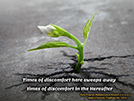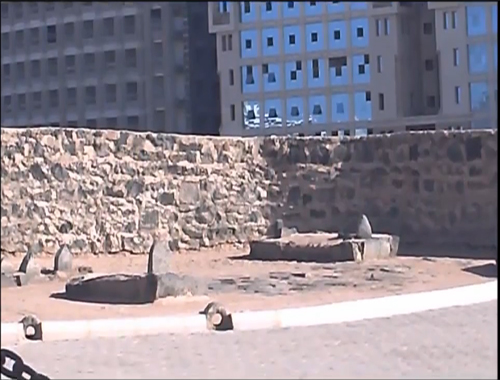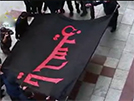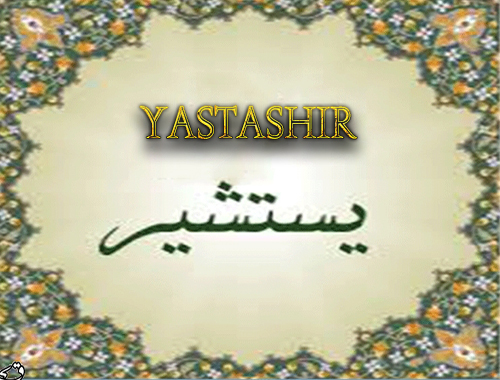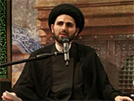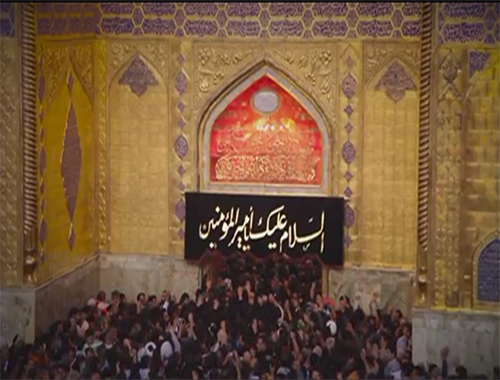Cemetery of Wadi al - salam
- Details
- Hits: 11681
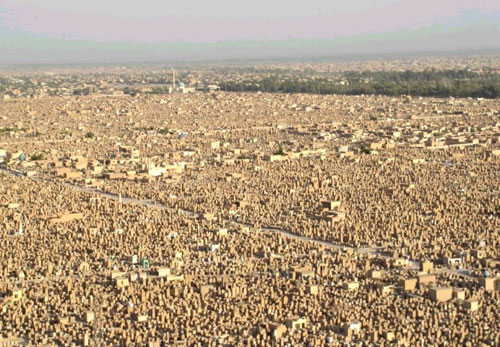
Wadi al - salam
a view of Wadi al-Salam cemetery, Najaf, Iraq
Wādī al-Salām (وادي السلام) is an extensive historic cemetery, situated in Najaf, a city of Iraq. It is of immense importance for shi'as due to many Hadiths regarding its significance. On the basis of some Hadiths, the cemetery is where some of the prophets and great virtuous men return after their death (Raj'at), and any pious man's spirit who passes away in any spot of the world will come to this cemetery. Its location in Najaf has raised its importance because of Imam 'Ali's holy shrine being there. Many pilgrims of 'Atabat al-'Aliyat (The holy shrine of Imams (a)) visit this area beside visiting other sacred places. Furthermore, a lot of religious, political, and social figures of shi'a have been buried there.
Why it has been named Wadi al-Salam?
The word "wadi" means a narrow area of land, prone to torrent, between two mountains, where the flood goes through and dwindles gradually. The word "al-salam" is one of Allah's name, denoting protection from inner and outer harms and dangers in Arabic language( Raghib, 421)
Some references believe this name has been selected by the Prophet of Islam (s) or Gabriel, meaning anyone entombed in this cemetery is exempt from the judgment and punishment of 'Alam al-Bardhakh (the world between this world and the future life).( Al-Buraqi, P.243)
Al-Kulayni (d. 328 AH/940) has narrated a Hadith about this cemetery, descended from Imam 'Ali (a) in which the phrase "Wadi al-Salam" is applied to suggest this cemetery.(Al-Kafi, Vol.3, P.243)
Wadi al-Salam in Hadiths
In some Hadiths, this cemetery is referred to by the term "beyond Kufa" (a city in Iraq), without mentioning the exact name "Wadi al-Salam". For instance, the Hadith narrated by al-Majlisi al-Thani (al-Majlisi II) from Ayyashi : "The first site on earth where God was worshiped was the back of Kufa. When God ordered the angels to prostrate for Adam (a), they obeyed behind Kufa"( Bihar-Ol-Anvar, Vol.22, P.37), said Imam 'Ali (a).
Geographical location and historical background
Wadi al-Salam is located in Najaf, a city of Iraq. Imam 'Ali (a)'s holy shrine and a street named 'Ali b. Abi Talib are situated in the south of it. It meets the road between Najaf and Karbala from the East, Hay al-Muhandisin region from the North, and former sea of Najaf from the West.
According to Hadiths, the background of this cemetery goes back to pre-Islamic era. There are not many historical proofs of its state before Islam; nevertheless, it appears that this place has been a cemetery since long time ago. Some Hadiths have extended its background to the time when the angels prostrated for Adam (a), as in a Hadith said to be from Imam 'Ali (a).( Bihar-Ol-Anvar, Vol.22, P.37)
On the basis of some Hadiths, some of the prophets have been buried in Wadi al-Salam. As Al-Majlisi narrated from al-'Ayyashi, this spot has been a place for Adam's prayer and some of other prophet's coming after him.( Bihar-Ol-Anvar, Vol.18, P.384)
It has been a see-sight for pilgrim Iranian caravans; however, most of the caravans prohibit their members from visiting this cemetery, for the country has been unsafe over the recent years. Being large and extensive and having tall tombs and old rooms, Wadi al-Salam seems so insecure lately.
Significance and superiority
One of the reasons to the importance of this cemetery is its proximity to Imam 'Ali's (a) holy shrine. In addition, it has been indicated and admired frequently in Shi'a references. It appears the earliest Hadith about it is one narrated by Al-Kulayni (255-329 AH/869-941 AD), said to be from Imam 'Ali (a). Subsequent references have narrated this Hadith numerously. In this Hadith, Imam 'Ali (a), accompanied with one of his companions, goes to Wadi al-Salam and uttered: "No pious man passes away on any part of the earth unless his spirit is ordered to come to Wadi al-Salam. Here, is a part of Heaven."( Al-Kafi, Vol.3, P.243)
Al-Majlisi al-Thani (Al-Majlisi II) has narrated that the Prophet of Islam (s), along with Gabriel, went to Wadi al-Salam and performed prayer in Ascension Night. According to this narration, Wadi al-Salam has been a place of prayer for Adam (a) and other prophets.( Bihar-Ol-Anvar, Vol.18, P.384)
Moreover, this is the first area of earth in which God was worshiped, as Hadiths witness.( Bihar-Ol-Anvar, Vol.22, P.37)
There are some Hadiths about Imam 'Ali's (a) interest in Najaf and Wadi al-Salam and his willingness to be buried in this city and in this cemetery. In particular, in a Hadith, Imam 'Ali (a) asks God to be buried in Wadi al-Salam cemetery.( Irshad-Ol-Gholoob, Vol.2, P.238)
Constructions inside the cemetery
Aside from the graves of the cemetery, some constructions have been built that have always been at the center of attention for Shi'a pilgrims. Some constructions, made to respect for great men at their tombs, are so valuable in the aspect of religion, history, and art. Such as:
The tombs ascribed to Hud (a) and Salih (a)
According to some Hadiths, two prophet's tombs, Hud (a) and Salih (a), are situated in Wadi al-Salam. In fact, there are two tombs said to belong to these two prophets. Initially, with 'Allama Bahr al-'Ulum's attempt, a dome and a construction composed of chalk and stone, were built. The construction was renovated with the aid of an Iranian benefactor, and the dome was ornamented with beautiful tiles in 1337 AH/1919.( Qa'idan, 'Ali Asghar. 1387 sh. 'Atabat 'Aliyat Iraq., P.50)
Maqam al-Imam al-Mahdi (a), Imam Sadiq (a), and Imam Sajjad (a)
At the north part of Wadi al-Salam, there is an area called Maqam al-Imam al-Mahdi (a) and Maqam al-Imam al-Sadiq (a). There is an almost old construction there, along with two signs, pointing the place where Imam Sadiq (a) and Imam al-Mahdi (a) have recited prayer. A blue dome is right above it. Inside, one can see a well, so called as Bi'r al-Imam al-Mahdi (a), surrounded by a few tombs. It is said that Imam al-Mahdi (a) was seen there.
The construction has been built thanks to Allama Bahr al-'Ulum's efforts. A person by the name of Sayyid Muhammad Khan refurbished it in 1370 AH/1951, and it has maintained its state until today. He, also, made a dome with blue tiles above the construction.
There is a stone in there on which Imam al-Mahdi's Ziyara (a blessing prayer for a Imam) is incised. Its date goes back to the year 1200 AH/1786. There has been narrated from Imam al-Sadiq (a) that:
"Anyone who visits my ancestor's tomb, should recite a prayer of two units, and again a two-unit one, and then another two units of prayer. The first prayer should be performed at the entrance of Imam Ali's (a) tomb, the second one at Ra's al-Husayn, and the third one at Imam al-Mahdi's (a) pulpit (al-minbar)".( Qa'idan, 'Ali Asghar. 1387 sh. 'Atabat 'Aliyat Iraq., P.50)
There is another area (maqam) inside this construction ascribed to Imam al-Sadiq (a). There is no evidence and information indicating the reason of this naming.
A mosque and a construction have been built in respect of Imam al-Sajjad's (a) prayer and staying there. It is located at one kilometer west of Imam 'Ali's (a) holy shrine, beside the lake Bahr al-Najaf at a distance of 250 meters, and adjacent to Safi Safa tomb. The dimensions of this mosque are 15*18. It has a dome, and the walls are decorated with tiles, and there is an altar (mihrab) ascribed to the area where Imam al-Sajjad (a) said prayer. It is said that when Imam al-Sajjad (a) came to visit Imam 'Ali's tomb in Najaf, he performed his prayer there and stayed for the night.
At the time when Safavid dynasty ruled Iraq, a construction was built in this area which still exists. Around the collapse of Ottoman Empire, it was repaired and a nice stone was put inside the altar, on which Huruf al-muqatta'a (The initial letters of words representing a secret phrase or sentence) are carved. The meaning of these letters is not known to anybody.( Qa'idan, 'Ali Asghar. 1387 sh. 'Atabat 'Aliyat Iraq., PP.50-1)
Figures entombed in Wadi al-salam
Many religious, political, and social figures of Shi'a have been buried in this cemetery by either their will or their relative's request. Seemingly, their purpose had been being adjacent to Imam 'Ali's (a) holy shrine. Some of shi'a figures entombed in this cemetery are:
Sayyid Jamal al-din Gulpayigani
Sayyid Muhammad Baqir al-Sadr
Sayyid Jamal al-din Afji'i
Sayyid 'Ali Qazi Tabataba'i
Ra'is 'Ali Delvari
Muhammad Husain Kashif al-Ghit'a
Muhammad Rida Tunikabuni
Sayyid Muhammad Baqir al-Hakim
Superstitious manners in cemetery
In November of 2012, an Iranian news agency by the name of Shafaqna informed about people's strange manners in this cemetery through a report. Accordingly, some people carve their names on a stone so that their spirit would come to this cemetery after death. They also pick the sole of cemetery as being sacred, or they bury their nails and hairs there. This news agency has called these actions superstitious. (Shafaqna.com)
Taken from: wikishia

